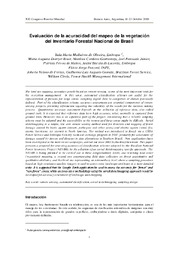Evaluación de la acuracidad del mapeo de la vegetación del Inventario Forestal Nacional de Brasil
Evaluación de la acuracidad del mapeo de la vegetación del Inventario Forestal Nacional de Brasil
Autoria: OLIVEIRA, Y. M. M. de; ROSOT, M. A. D.; GARRASTAZU, M. C.; PENTEADO JUNIOR, J. F.; MATTOS, P. P. de; LACERDA, A. E. B. D.; PONZONI, F. J.; FREITAS, J. V. de; GOMIDE, L. A.; CIESLA, W.
Resumo: The land use mapping, nowadays greatly based on remote sensing, is one of the most important tools for the ecosystem management. In this sense, automated classification schemes are useful for the representation of features for large areas, assigning digital data to categories or classes previously defined. Part of the classification scheme, accuracy assessments are essential components of remote sensing projects, providing information regarding the reliability of the results for the decision making process. Quantitative accuracy assessment depends on the collection of reference data, also called ground truth. It is expected that reference data have high accuracy, what, normally is captured from ground visits. However, this is an expensive part of the project, considering that a reliable sampling scheme must be adopted and the accessibility to the remote and large areas might be difficult. Aerial sketchmapping is a simple, low cost remote sensing method used for detection and mapping of forest damage caused by biotic agents (insects, pathogens and other pests) and abiotic agents (wind, fire, storms, hurricane, ice storms) in North America. The method was introduced in Brazil via a USDA Forest Service and Embrapa Forestry technical exchange program in 2001, primarily for assessment of damage caused by insects and diseases in pine plantations in Southern Brazil. New applications have been investigated in the most recent campaigns, carried out since 2002 by the Brazilian team. This paper presents a proposal for assessing accuracy of classification schemes adopted by the Brazilian National Forest Inventory Project (NFI-BR), by the adoption of an aerial sketchmapping specific approach. The NFI-BR is being planned to be carried out in three complementary levels, one involving land cover (vegetation) mapping, a second one encompassing field data collection on forest quantitative and qualitative attributes, and the third one representing an intermediary level where a sampling procedure based on high resolution satellite imagery is used to assess some landscape attributes in a more detailed scale. It is suggested that the Google Earth application be used to assess the accuracy for “forest” and “non-forest” strata, while an innovative methodology using the aerial sketchmapping approach would be developed for accuracy assessment of landscape units mapping.
Ano de publicação: 2009
Tipo de publicação: Artigo em anais e proceedings
Unidade: Embrapa Florestas
Observações
1 - Por padrão são exibidas publicações dos últimos 20 anos. Para encontrar publicações mais antigas, configure o filtro ano de publicação, colocando o ano a partir do qual você deseja encontrar publicações. O filtro está na coluna da esquerda na busca acima.
2 - Para ler algumas publicações da Embrapa (apenas as que estão em formato ePub), é necessário ter, no celular ou computador, um desses softwares gratuitos. Sistemas Android: Google Play Livros; IOS: iBooks; Windows e Linux: software Calibre.
Acesse outras publicações
Acesse a Base de Dados da Pesquisa Agropecuária (BDPA) para consultar o acervo completo das bibliotecas da Embrapa.

